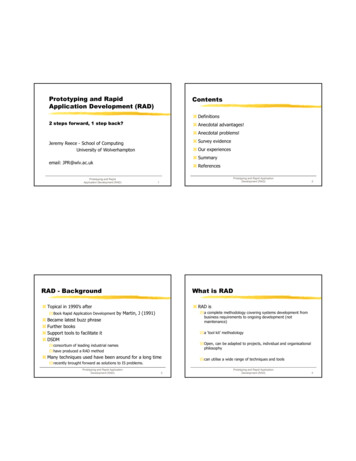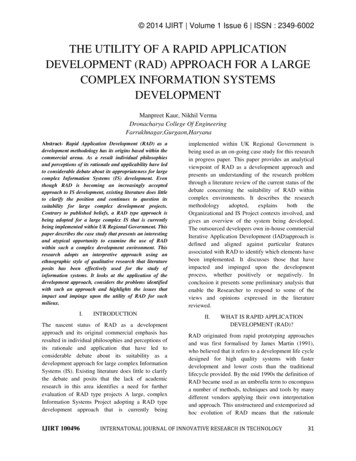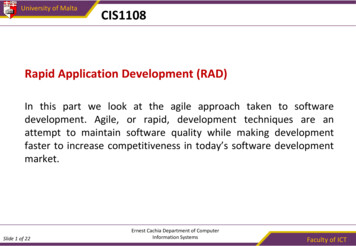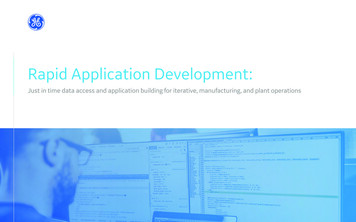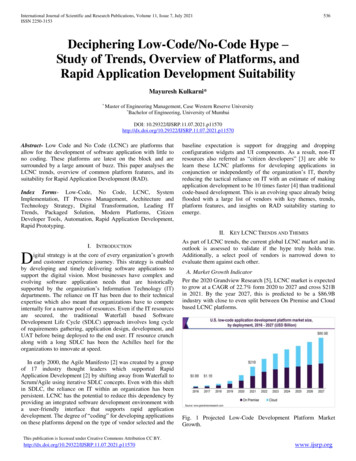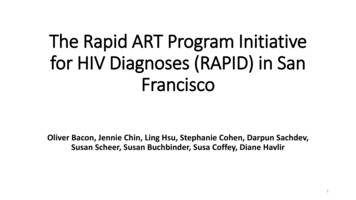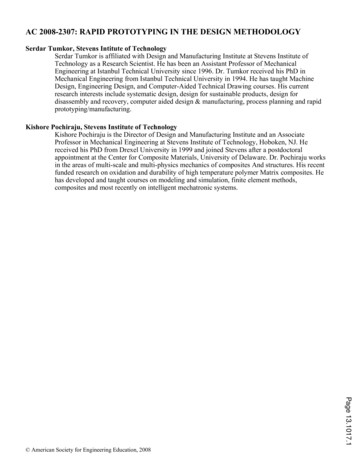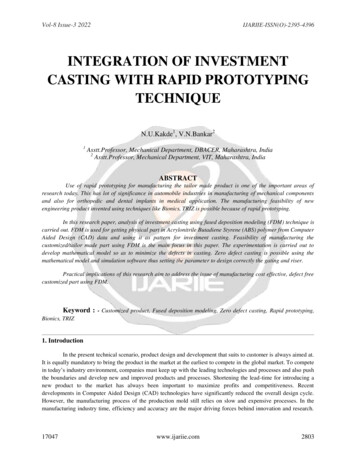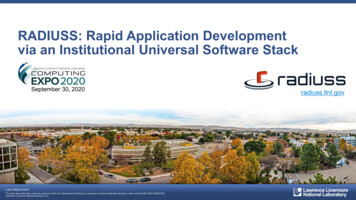
Transcription
RADIUSS: Rapid Application Developmentvia an Institutional Universal Software StackSeptember 30, 2020LLNL-PRES-814279This work was performed under the auspices of the U.S. Department of Energy by Lawrence Livermore National Laboratory under contract DE-AC52-07NA27344.Lawrence Livermore National Security, LLCradiuss.llnl.gov
Build ToolsLLNL-PRES-814279
Technical ContactBuild ToolsTodd siteRepositoryContactSpackA flexible package managerfor HPCApache-2or MIT 7spack.iogithub.com/spack/spackToddGamblinBLTA streamlined CMake buildsystem foundation for HPCsoftwareBSD 2llnl-blt.readthedocs.iogithub.com/LLNL/bltChris WhiteShroudEasily create Fortran, C andPython interfaces for C orC librariesBSD 3.5shroud.readthedocs.iogithub.com/LLNL/shroudLee TaylorLLNL-PRES-814279
SpackA flexible package manager for HPC Automates complex builds— Easily manage hundreds of dependencies, down to versions and build options— Easily test complex software with many compiler/MPI/BLAS combinations Easily share and leverage others’ work— Leverage a library of 4,000 community-maintained package recipes— Leverage others’ internal/proprietary libraries with internal LLNL repositories— Allow other users and developers to easily use your software Broad use inside and outside the laboratories— ASC, LC, ENG, others at LLNL; codes at LANL, SNL, Fermi, ORNL, ANL, ECP— Nearly 3,000 worldwide users (per docs site), highly active community on GitHubSpack users worldwide@spackpmLLNL-PRES-814279
BLTA streamlined CMake build system foundation for HPC software Simple macros for complex tasks— Create libraries, executables, and tests— Manages compiler flags across multiple compiler families— Unifies complexities of external dependencies into one easy to remember nameHPC Programming Models Batteries included— Example configurations for most LC/Linux/OSX/Windows system and compilerfamilies— Built-in support for: HPC programming models Code health Documentation generation Open sourceCode HealthFruitClang-queryUncrustifyAstyle— Leveraged by ALE3D, Ascent, Axom, CHAI, Conduit, FloBat, GeosX, Kripke, LEOS,MSLIB, RAJA, RAJA Perf Suite, Umpire, VBF Shaft, VTK-hLLNL-PRES-814279Documentation
ShroudEasily create Fortran, C, and Python interfaces for C or C libraries Generate wrappers with an annotated description of the C API— YAML input with C declarations for namespace, typedef, function, class, andstruct— Annotations to provide semantic information: intent, dimension, ownershipFortranPython— Allows user control of generated names for functions and interfaces— Provides hooks to allow custom code to augment or replace generated wrapper Creates a Fortran idiomatic interfaceC— Preserves object-oriented API— No need to be a Fortran expert to create Fortran wrapper— Uses C as lingua franca to access C Use the same YAML file to create a Python module— Creates an extension module, no Python source code is created— Support for NumPyLLNL-PRES-814279User’s C/C code
Portable Execution andMemory ManagementLLNL-PRES-814279
Portable Execution and MemoryManagementTechnical ContactDavid )WebsiteRepositoryContactRAJALoop-level abstractions to targetmachine-specific programmingmodels and constructsBSD 5software.llnl.gov/RAJAgithub.com/LLNL/RAJARich HornungCHAIOptional add-on to RAJA forautomating data motion betweenmemory spacesBSD ckingsaleUmpireAn application-focused API formemory management on NUMA& GPU architecturesMIT idBeckingsaleLvArrayArray classes for highperformance simulation softwareBSD 2lvarray.readthedocs.iogithub.com/GEOSX/LvArrayBen CorbettLLNL-PRES-814279
RAJALoop-level abstractions to target machine-specific programming models and constructs Provides a portable API for loop execution Powerful “kernel” API to express nested, multi-dimensional loops Other portable featuresfor (int i 0; i N; i) {a[i] c * b[i];}A simple C-style loop— Reductions, scans, sorts, atomics, and multi-dimensional data views Supports multiple back-end targets: OpenMP, CUDA, AMD, Easy to integrate into existing applications— Loop bodies remain generally unchanged— Can be adopted incrementally, one loop at a timeforall EXEC POL (RangeSegment(0, N),[ ] (int i) {a[i] c * b[i];});Same loop using RAJA Open source— Used by ASC and ATMD applications and libraries, and ECPprojects: SAMRAI, MFEM, SUNDIALS, hypre, SW4, GEOS-X,ExaSGD, Alpine, etc.LLNL-PRES-814279Loop execution defined by “execution policy”:EXEC POL can be seq exec, openmp exec,cuda exec, etc.
UmpireAn application-focused API for memory management on NUMA and GPU architecturesUmpire Simple and unified API to a wide range of memory resources:— DDR— NVIDIA GPU memory Constant memory— AMD GPU memoryauto allocator rm.getAllocator(“DEVICE”);double* data );— NUMA supportAPI Provides high-performance “strategies” for customizing data allocation:Umpire— Memory pools, buffers, CUDA memory adviceImplementations “Operations” to copy, move, set data on any memory resource Open sourcememkindcnmemtcmallocSICMcudaMalloc— Underpins CHAI— Used by LLNL ASC and ATDM applications, SW4, SAMRAI, MFEMHardwareDDRLLNL-PRES-814279GDDR
CHAIOptional add-on to RAJA for automating data transfers between memory spaces Array-like object with automatic data migration Provides “unified memory” without any special system support Integrates with RAJA— Could be used with other programming models Uses Umpire, and behavior can be customized using differentUmpire “Allocators” Open source— Used in LLNL ASC applications— Works with Umpire & RAJAchai::ManagedArray double data(100);RAJA::forall cuda exec (RangeSegment(0, 100), [ ] (int i) {data[i] i;});RAJA::forall seq exec (RangeSegment(0, 100), [ ] (int i) {printf(“data[%g] %f\n”,i, data[i]);});CHAI arrays can be used on CPU or GPU,data migrates without user interventionLLNL-PRES-814279
LvArrayContainers for use in high-performance simulation software Containers— A multi-dimensional array with a customizablememory layout and slicing.— A sorted unique list of values.— A jagged two-dimensional array.— A compressed row storage matrix and sparsitypattern. All containers support customizable allocationbehavior and work on device Integrates with RAJA and optionally CHAI Open source— BSD license— Used by GEOSX ECP projectLvArray::Array double,2, x(10, 11);forall POLICY1 (x.size(0),[x x.toView()](int i){for(int j 0; j x.size(1); j )x(i, j) foo(i, j);} );LvArray::Array double,2, sums(x.size(0));forall POLICY2 (x.size(0),[x x.toViewConst(), sums sums.toView()](int i){for(double value : x[i])sums[i] value;} );sums.move(LvArray::MemorySpace::CPU);std::cout sums std::endl;When using CHAI POLICY1 and POLICY2 can be any RAJApolicy and the data will migrate appropriately.LLNL-PRES-814279
Application CS InfrastructureLLNL-PRES-814279
Technical ContactApplication CS InfrastructureRich siteRepositoryContactAxomFlexible software infrastructure for thedevelopment of multi-physicsapplications and computational toolsBSD 5software.llnl.gov/axomgithub.com/LLNL/axomRich HornungPlease direct detailed technical questions to the Axom developer team:axom-dev@llnl.govLLNL-PRES-814279
Application CS Infrastructure (Axom) Motivated by LLNL ASC next-generation code planning— Core infrastructure for the LLNL ATDM code— Used across the LLNL ASC code portfolio The report (at right) contains 50 recommendations spanning— Software architecture and design— Software processes and tools— Software sharing and integration— Performance and portability— Co-design, external interactions, research In development for 5 years Open sourceLLNL-PRES-814279
Application CS Infrastructure (Axom)Mesh-aware data schema“coordsets”: {“coords”: uble],“y”:[double]}}},“topologies”: { P0P1{File 0File 1P2P3Surface queries & spatialacceleration data structuresUnified inter/intra-package messagelogging & parallel filteringMesh data modelLLNL-PRES-814279Parallel file I/O & burstbuffer supportHierarchical key-valuein-memory datastore
Application CS Infrastructure (Axom) Examples of Axom application support— Centralized, hierarchical simulation data management— Parallel file I/O for checkpoint-restart and visualization— Access to in-situ visualization and analysis tools— Shaping in arbitrary, complex material geometries— Immersed boundaries, interfaces— Building blocks for particle-based algorithms— Integrated cross-package parallel message loggingmaterial Bmaterial Acell 1cell 2material Ccell 3LLNL-PRES-814279cell 4
Application CS Infrastructure (Axom)AxomComponentDescriptionSidreIn-core hierarchical key-value data management, plus parallel file I/O (restart, viz. files), support for heterogeneousmemory systems, etc.QuestSpatial point/surface queries; in-out, signed distance, point containment, point-in-cell, etc.PrimalGeometric primitives (point, vector, triangle, etc.) and operations (distance, intersection, closest point, etc.)SpinSpatial acceleration data structures; octree, kd-tree, R-tree, BVH, etc.MintMesh data model; structured, unstructured, particles.SlamSet, relation, map abstractions.Slic/LumberjackUnified/shared inter-package message streams, parallel logging, and filtering.All Axom components provide native interfaces for C , C, and Fortran (Python in the works).LLNL-PRES-814279
Math Physics LibrariesLLNL-PRES-814279
Technical ContactMath Physics LibrariesTzanio teRepositoryContactMFEMUnstructured high-order finiteelement libraryBSD 15mfem.orggithub.com/mfemTzanio KolevhyprePreconditioners and solvers forlarge-scale matricesApache-2or MIT 20www.llnl.gov/casc/hypregithub.com/hypre-spaceRob FalgoutSUNDIALSNonlinear anddifferential/algebraic equationsolversBSD lsCarolWoodwardSAMRAIStructured Adaptive MeshRefinement frameworkLGPL-2.1 LNL/SAMRAINoah ElliottXBraidLightweight support for multigridParallel-in-TimeLGPL-2.1 5www.llnl.gov/casc/xbraidgithub.com/xbraidRob FalgoutLLNL-PRES-814279
MFEMLightweight, scalable C library for finite element methods Supports arbitrary high-order discretizations and meshes for a wide variety ofapplications Flexible discretizations on unstructured grids— Triangular, quadrilateral, tetrahedral and hexahedral meshes.— Local conforming and non-conforming refinement.High-ordercurved elementsParallel non-conforming AMR— Bilinear/linear forms for variety of methods: Galerkin, DG, DPG, High-order and scalable— Arbitrary-order H1, H(curl), H(div)- and L2 elements. Arbitrary order curvilinear meshes.— MPI scalable to millions of cores and GPU-accelerated. Enables application developmenton wide variety of platforms: from laptops to exascale machines. Built-in solvers and visualization— Integrated with: HYPRE, RAJA, UMPIRE, SUNDIALS, PETSc, SUPERLU, — Accurate and flexible visualization with VisIt and GLVis Open sourceSurfacemeshes— BSD license with thousands of downloads/year worldwide.— Available on GitHub. Part of ECP’s CEED co-design center.LLNL-PRES-814279HeartmodelingCompressible flowALE simulations
HypreHighly scalable multilevel solvers and preconditioners Conceptual linear system interfaces— Provides natural “views” of the linear system: structured, semi-structured, finiteElasticity / plasticityelement, linear algebraic— Enables more efficient data storage schemes and kernels Scalable preconditioners and solvers— Structured and unstructured algebraic multigrid (including constant coefficient)— Maxwell solvers, H-div solvers, and more— Demonstrated scalability beyond 1M cores Integrated with other math libraries— SUNDIALS, PETSc, Trilinos Unique, user-friendly interfaces Open source— Used worldwide in a vast range of applications— Available on GitHub, Apache-2 or MIT odynamicsFacial surgery
SUNDIALSAdaptive time integrators for ODEs and DAEs and efficient nonlinear solvers ODE integrators:— CVODE(S): variable order and step BDF (stiff) and Adams (non-stiff)— ARKode: variable step implicit, explicit, and additive IMEX Runge-Kutta DAE integrators: IDA(S) - variable order and step BDF integrators Sensitivity analysis (SA): CVODES and IDAS provide forward and adjoint SA Nonlinear solvers: KINSOL - Newton-Krylov, Picard, and accelerated fixed point Modular designMagnetic reconnectionCore collapse super-nova— Written in C with interfaces to Fortran— Users can supply own data structures and solvers— Optional use structures: serial, MPI, threaded, CUDA, RAJA, hypre, & PETSc— Encapsulated parallelism Open source— Freely available (BSD License) from LLNL site, GitHub, and SpackDislocation dynamics— CMake-based portable build system— Can be used from MFEM, PETSc, and deal.II Supported by extensive documentation, a sundials-users email list, and an active usercommunity Used by thousands worldwide in applications from research and industryLLNL-PRES-814279Subsurface flow
XBraidParallel-in-time multigrid solver software Speeds up existing application codes by creating concurrency in the time dimension Unique non-intrusive approachMoving Mesh— Builds as much as possible on existing codes and technologies Demonstrated effectiveness and potential— Tech: Implicit, explicit, multistep, multistage, adaptivity in time and space, movingTime — Converges to same solution as sequential codemeshes, spatial coarsening, low storage approachParallelize space and timeStore several time steps— Apps: Linear/nonlinear diffusion, fluids (shocks), power grid (discontinuities), elasticity,optimization, — Codes: Strand2D, Cart3D, LifeV, CHeart, GridDyn, — Extensive work developing scalable multigrid methods in hypreTime Leverages spatial multigrid research and experienceInviscid BurgersNavier-StokesPower Grid Open source— Available on GitHub, LGPL-2.1LLNL-PRES-814279Up to 50x speedup on some problems (so far)
SAMRAIStructured adaptive mesh refinement applications infrastructure Object-oriented library, scalable and flexible for use in many applications Full support of AMR infrastructure Multi-level dynamic gridding of AMR mesh Transparent parallel communication (MPI) Load balancing Data type for common mesh centerings (cell, node, face, . . .) Data transfer operations (copy, coarsen, refine, time interpolation) Flexibility provided to applicationsFixed geometryEulerian methodsLagrangianmoving grids Applications provide numerical kernels to operate on distributed patches Users may define and own their own data structures Works on different geometries (Cartesian, staggered, multiblock, etc.) Applications choose when and where to use SAMRAI data structures Interfaces to solver libraries included (hypre, SUNDIALS, PETSc) VisIt visualization and HDF5 checkpoint/restart supported Open source LGPL 2.1 license, available on GitHubLLNL-PRES-814279Multi-physicsapplications RAJA threadinginterfaces andUmpire memorymanagement forGPUs are beingdeveloped CMake-based buildsystem comingsoon
Performance andWorkflow ToolsLLNL-PRES-814279
Performance and Workflow ToolsTechnical ContactMatthew bsiteRepositoryContactCaliperAlways-on performancemeasurement libraryBSD id BoehmeSPOTPerformance history xResource management andschedulingLGPL-3.0 6flux-framework.orggithub.com/flux-frameworkDong AhnMaestroWFA tool and library forspecifying and conductinggeneral workflowsMIT wfFrank Di NataleSpindleLibrary loading and programstart-up at scaleLGPL-2.1 /spindleMatthewLeGendreLBANNMachine learning training andinference at extreme scaleApache-2 5.5lbann.readthedocs.iogithub.com/LLNL/lbannBrian VanEssenLLNL-PRES-814279
CaliperA library for always-on performance monitoring Add simple annotations to source code— Physics regions, Key loops, other semantics Link code with Caliper library from C , C, or Fortran Attach arbitrary performance measurement tools to your regions Leave Caliper in and always have performance data availableLLNL-PRES-814279
SPOTPerformance analysis and history tracking Collect performance results from arbitrary application runs, track performanceacross users and history Integrate performance analysis tools into applicationsPerformance Dashboards— Annotate code regions with Caliper— Control performance collection through command line or input deck— Store history of performance data and visualize through web interfaces Caliper interfaces with applications— Annotation interface puts labels on code and data regions— Varity of metrics (time, memory bandwidth, MPI usage, etc.) are collected andreported against annotation labels.History Tracking— More reliable that traditional performance tools. SPOT visualizes history of Caliper-collected runs— Any application run can report performance data to SPOT.— Track how performance changes with code releases and across systems— Explore performance data to identify issues Under active development & integrated into several large codesLLNL-PRES-814279Drill-Down on Performance with Specialized Visualizations
FluxNext-generation resource management and scheduling framework to addressemerging challenges Workflow challenges— Modern Workflows are increasingly difficult to schedule— Cancer Moonshot Pilot2, Machine Learning LDRD StrategicInitiative, Resource challenges— Changes in resource types are equally challenging— GPGPUs, Burst buffers, under-provisioned PFS BW, Fully hierarchical approach for job throughput/co-scheduling Graph-based resource model for resource challenges Rich APIs for workflow communication and coordination Consistent APIs for workflow portability and reproducibility@FluxFrameworkLLNL-PRES-814279
MaestroWFA standard framework to make simulation studies easier to manage,run, and expand Consistent study specification definitionsay-hi— Specify multi-step workflows in a human-readable and self-documentingYAML specification.— Studies can be linear or parameterized, are easily shareable between users,and can be software amBye,JimBye,KellyBye,MichaelBye,Pam— Easily repeat studies simply by launching an existing specification. Lightweight workflow automation and monitoring— Studies are parsed, expanded based on parameters, and monitoredautomatically.— Workflows are expanded into DAGs, with workflow steps being launched astheir dependencies allow them. Easy for users to specify and launch workflows— Specifications being shareable allows existing studies to serve as templatesfor new ones (making both set up and knowledge sharing easier).— A study specification allows users to build standard infrastructure to generatethe necessary YAML to run larger collections of studies.LLNL-PRES-814279
SpindleScalable application start-up Job launch not scalable with many libraries or Python— Solves start-up issues from loading libraries and Pythonmodules at scale— Nodes hammer shared file systems when searching andloading libraries— Impacts users across whole center Spindle makes job launch scalable— Single node loads libraries/python-modules.— Broadcasts libraries to other nodes over high-bandwidthcommunication network.— Run by: % spindle srun –n 512 ./myapp Open source— LGPL-2.1 with thousands of downloads/year worldwide— Available on GitHubLLNL-PRES-814279
LBANNLivermore Big Artificial Neural Network Toolkit Distributed deep learning training and inference— Optimize for strong and weak scaling network training— Train large networks quicklyLBANNScalable Deep Learning ToolkitMPI— Enable training on data samples or data sets too large for otherframeworks (e.g., 3D data cubes, billion sample data sets)— Optimized distributed memory algorithm— Including spatially decomposed convolutions— Multi-level parallelism (model / data / ensemble)— Hydrogen GPU-accelerated distributed linear algebra library— Optimized asynchronous GPU-aware communication libraryHydrogenGPU-AcceleratedDistributed Linear AlgebraAluminumHigh-performance GPU-awarecommunity libraryDistributed Linear Algebra Utilize unique HPC resources at scale Low latency / high cross-section bandwidth Open source under Apache license— Node-local NVRAM— github.com/LLNL/lbann— High bandwidth parallel file system— github.com/LLNL/Elemental C / MPI OpenMP / CUDA / ROCm / NCCL / cuDNNLLNL-PRES-814279NCCL MPI P2PNCCL NVSHMEMCPU-Only— InfiniBand and next-generation interconnect— Tightly-coupled GPU acceleratorsCUDA-aware MPI— github.com/LLNL/AluminumGPU-Accel
Data Management andVisualizationLLNL-PRES-814279
Data Management and VisualizationTechnical ContactCyrus bsiteRepositoryContactConduitSimplified data exchange for HPCsimulationsBSD yrusHarrisonAscentFlyweight in situ visualization andanalysis for HPC simulationsBSD 4ascent-dav.orggithub.com/alpinedav/ascentMatt LarsenzfpIn-memory compression of floatingpoint arraysBSD omSCRMultilevel checkpointing support andburst buffer interfaceBSD rorVisItFeature-rich mesh-based visualizationand analysis platformBSD risonGLVisLightweight high order visualization forMFEMLGPL-2.1 11glvis.orggithub.com/GLVis/glvisTzanio KolevLLNL-PRES-814279
ConduitSimplified data exchange for HPC simulations Provides an intuitive API for in-memory data description— Enables human-friendly hierarchical data organization— Can describe in-memory arrays without copying— Provides C , C, Python, and Fortran APIs Provides common conventions for exchanging complex data— Shared conventions for passing complex data (e.g., simulationmeshes) enable modular interfaces across software libraries andsimulation applications Provides easy to use I/O interfaces for moving and storing dataHierarchical in-memory data description— Enables use cases like binary checkpoint restart— Supports moving complex data with MPI (serialization) Open source— Leveraged by Ascent, VisIt, and AxomConventions for sharing in-memory mesh dataLLNL-PRES-814279
AscentFlyweight in-situ visualization and analysis for HPC simulations Ascent is an easy to use in-memory visualization and analysis library— Use cases: making pictures, transforming data, and capturing data— Young effort, yet already supports most common visualization operations— Provides a simple infrastructure to integrate custom analysis— Provides C , C, Python, and Fortran APIs Uses a flyweight design targeted at next-generation HPC platforms— Efficient distributed-memory (MPI) and many-core (CUDA or OpenMP) executionVisualizations created using Ascent— Has lower memory requirements then current tools Demonstrated scaling: In situ filtering and ray tracing across 16,384 GPUs onLLNL’s Sierra Cluster— Requires less dependencies than current tools (e.g., no OpenGL) Open source— Leverages Conduit, will also be released with VisitLLNL-PRES-814279Extracts supported by Ascent
VisItFull-featured visualization and analysis for HPC simulations Production end-user tool supporting scientific and engineering applications— Use cases: data exploration, quantitative analysis, visual debugging,VisItcomparative analysis and generation of presentation graphics— Provides a rich feature set and a flexible data model suitable for many scientificdomains— Includes more than 100 file format readers— Provides GUI and Python interfaces, extendable via C and Python Provides parallel post-processing infrastructure that scales from desktops tomassive HPC clusters— Uses MPI for distributed-memory parallelism on HPC clusters— Development underway to leverage on-node many-core (CUDA or OpenMP)parallelism Open source— Used as a platform to deploy research from the DOE visualization community— Initially developed by LLNL to support ASC, now co-developed by severalorganizationsLLNL-PRES-814279Visualizations created using VisIt
GLVisLightweight OpenGL tool for accurate and flexible interactive finite element visualization Accurate visualization—1D/2D/3D, volume/surface, triangular/quad/tet/hex, low/high-order meshes—Arbitrary high-order, scalar and vector finite element and NURBS solutions—Visualization of parallel meshes and solutionsLightweight and interactive—Unlimited number of refinement and de-refinement levels—Support for antialiasing, accurate cutting planes, materials, lighting, and transparency—Processor and element shrinking for better visualization of 3D mesh interiorsSupports generalmeshes and fieldsVisualization of a time-dependenthigh-order BLAST simulationFlexible server support—Simultaneous visualization of multiple fields/meshes in separate GLVis windows—Local visualization for remote parallel runs with secure socket connections—Persistent visualization of time-evolving fieldsOpen source—LGPL-2.1. Available on GitHub—Based on the MFEM finite element library—Used in MFEM, MARBL/BLAST, LiDO, and moreGLVis server sessions with multiple windowsLLNL-PRES-814279
Scalable Checkpoint/Restart (SCR) LibraryEnables fast, portable I/O to burst buffers across HPC systems SCR provides fast, scalable I/O performance for LLNL applications— SCR caches output data in node local storage like RAM disk or burst buffer, whichcan be as much as 1000x faster than the parallel file system— SCR hides the complexity of different burst buffer systems and storagearchitectures Easy integration into application codes— Simple wrapper API around existing checkpoint/restart code— Full featured scripting tools wrap existing job launch commands, e.g. srun scr srun SCR now enables fast I/O for general output from applicationsSCR’s I/O strategies scale with the number ofnodes in an HPC job— SCR can now cache visualization dumps or other output to node local storage anddrain data to the parallel file system in the background— Applications can output data more frequently without the overhead Open source— Available on GitHub with BSD licenseLLNL-PRES-814279SCR protects yourdata and managesthe complexity ofHPC storagehierarchies forperformanceportable I/O
ZFPIn-memory compression of floating-point and integer arrays Provides a conventional array interface for multidimensional scalar fields— Supports constant-time read & write random access to any array element— Hides complexity of (de)compression via C operator overloading— Provides efficient data access via iterators, views, proxy references and pointersRaw floatingpoint arrayBlock floatingpoint edbit stream— Supports thread safe access and STL algorithms Provides a simple API for (de)compression of whole arrays— Supports prescribed error tolerance or precision, exact storage, losslesscompression— Supports OpenMP and CUDA parallel (de)compression at up to 150 GB/svirtual arraycompressed blocksapplicationsoftware cachethroughput— Provides C , C, Python, and Fortran APIs— Suitable for compressing checkpoints, viz dumps, MPI messages, CPU-GPUtransfers Open source— BSD licensed and available via GitHub, Spack, and Fedora RPM— Supported by Intel IPP, HDF5, Silo, ADIOS, VTK-m, LEOS, E4S, 240:1 compressionLLNL-PRES-814279
/RADIUSSDisclaimerThis document was prepared as an account of work sponsored by an agency of the United States government. Neither the United Statesgovernment nor Lawrence Livermore National Security, LLC, nor any of their employees makes any warranty, expressed or implied, orassumes any legal liability or responsibility for the accuracy, completeness, or usefulness of any information, apparatus, product, or processdisclosed, or represents that its use would not infringe privately owned rights. Reference herein to any specific commercial product, process,or service by trade name, trademark, manufacturer, or otherwise does not necessarily constitute or imply its endorsement, recommendation,or favoring by the United States government or Lawrence Livermore National Security, LLC. The views and opinions of authors expressedherein do not necessarily state or reflect those of the United States government or Lawrence Livermore National Security, LLC, and shall notbe used for advertising or product endorsement purposes.
RADIUSS: Rapid Application Development via an Institutional Universal Software Stack September 30, 2020 radiuss.llnl.gov. LLNL-PRES-814279 Build Tools. LLNL-PRES-814279 Build Tools. Project Description. License. Maturity (years) Website. Repository. Contact. Spack; A flexible package manager for HPC. Apache-2 or MIT 7.
